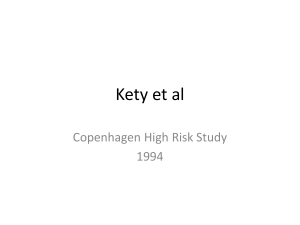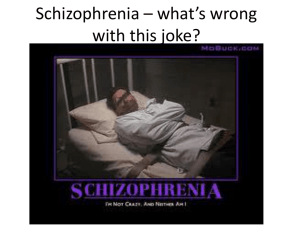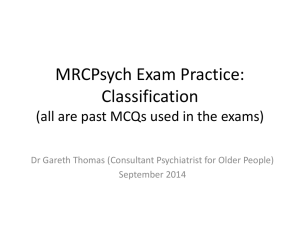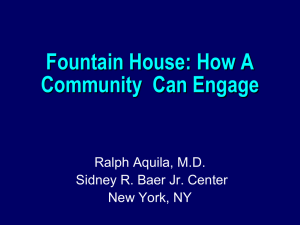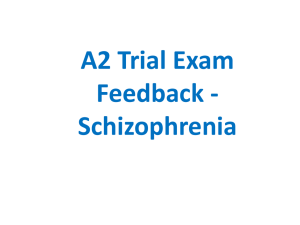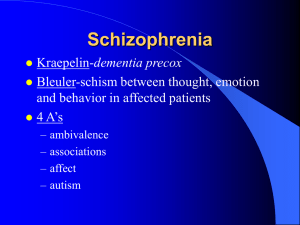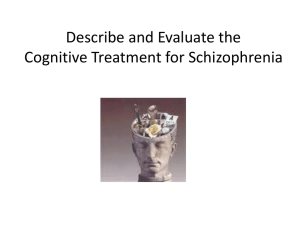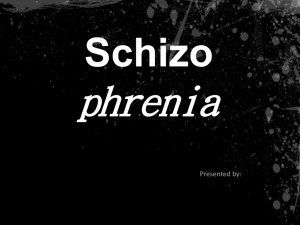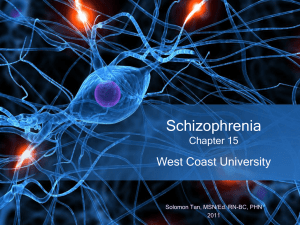Schizophrenia
advertisement
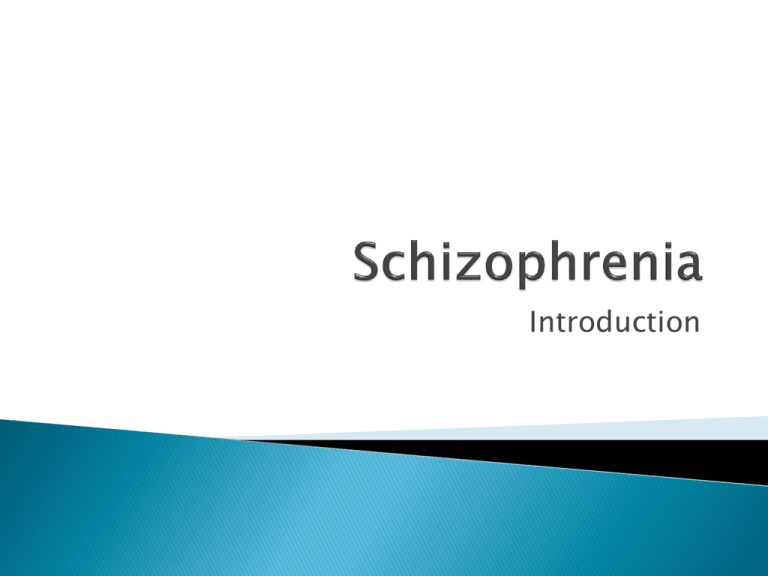
Introduction A biological disorder of the brain which causes disturbances in thinking speech, perception of reality, emotion (mood), and behavior. Approximately 1% of the population develops schizophrenia during their lifetime. Although schizophrenia affects men and women with equal frequency, the disorder often appears early in men (usually late teens), than women (generally late twenties/early thirties). Rarely is schizophrenia diagnosed in early childhood development • • • World Health Organization has identified schizophrenia as one of the ten most debilitating diseases affecting human beings. People with schizophrenia often suffer from terrifying symptoms such as hearing voices, believing that people can read their minds, controlling their thoughts and are plotting against them These symptoms leave them fearful and withdrawn. Introduced in 1911 by Psychiatrist Eugene Bleuer Dr. Bleuer suggested that psychological functions that are normally integrated with one another(such as thoughts, emotions and language) are somehow split apart from or are disconnected in people with schizophrenia. The term schizophrenia literally means “split mind” ◦ People often mistake “split mind” with split personality. 1. Paranoid Schizophrenia 2. Disorganized Schizophrenia 3. Catatonic Schizophrenia 4. Undifferentiated Schizophrenia 5. Residual Schizophrenia • Delusions of being prosecuted by others • Delusions of grandeur where they are enormously important • Suspicious, anxiety and anger • Hallucinations may also be present • Confusion and Incoherence • Severe deterioration of adaptive behavior – Lack of social skills – Poor personal hygiene & self care • Behavior appears silly and/or child-like • Highly in appropriate emotional responses • • Striking motor disturbances ranging from muscular rigidity to random or repetitive movements Alternate between stuperous states and agitated excitement – During stuperous states, people with catatonic schizophrenia may exhibit catatonic rigidity which is a phenomenon where they maintain an unusual position for up to several hours. This phenomenon is known as waxy flexibility People who exhibit some of the symptoms and thought disorders of the other subtypes but do not have enough of the specific criteria to be diagnosed within another category. Less common subtype Characterized by extended periods without prominent positive symptoms, but other symptoms continue Symptoms 1. Positive 2. Negative 3. Cognitive 4. Affective Positive “Psychotic” Symptoms Characterized by the presence of odd or unusual feelings, thoughts, and behaviors Negative, an absence of normal reactions “Negative” does not refer to the persons attitude, but rather the lack of certain characteristics that should be there Cognitive Pertain to thinking processes MATRICS ◦ Measurement And Treatment Research to Improve Cognition in Schizophrenia Affective Influenced by and resulting from emotion Risk Factors • Three Types of Biological Factors – Genetic Predisposition: If your related to someone diagnosed with schizophrenia the more likely you could develop the disorder. – Brain Abnormalities: Brain scans of schizophrenic patients have shown a number of brain abnormalities. • MRI’s Show mild to moderate brain atrophy • It is more likely to see these structural differences in patients who have negative symptom patterns. – Biochemical Factors: People who are diagnosed with schizophrenia have more dopamine receptors on neuron membranes then people who don’t have it. • Dopamine Hypothesis- the symptoms of schizophrenia, particularly positive symptoms, are produced by over activity of the dopamine system in areas of the brain that regulate emotional expressions, motivated behavior, and cognitive functioning (Heinrichs, 2001) Psychological Factors ◦ Regression is when a person retreats to an earlier and more secure state of psychosocial development in the face of overwhelming anxiety. ◦ It is believed by some cognitive theorists that it is a defect in the attentional mechanism that filters out irrelevant stimuli, so they become overwhelmed by internal and external stimuli. Environmental Factors ◦ Stressful life events can play an important role in showing the signs of schizophrenia . ◦ Expressed emotion involves high levels of criticism, hostility and over involvement. ◦ Schizophrenics who are returning home from the hospital are more likely to relapse if their environment is an expressed emotion. Sociocultural Factors ◦ Lower socioeconomic populations have a higher prevalence of schizophrenia. ◦ Social Causation hypothesis: attributes the higher prevalence of schizophrenia to the higher levels of stress that lowincome people experience. ◦ Social drift Hypothesis: Proposes that as people develop schizophrenia, their personal and occupational functioning deteriorates, so that they drift down the social ladder. Diagnosing Currently no physical or lab test absolutely diagnose schizophrenia. Primary method for diagnosing Schizophrenia are psychological evaluations Rule out other disorders Some lab test help confirm Schizophrenia Delusions Paranoid delusions Delusions of reference Somatic delusions Delusions of Grandeur Hallucinations ◦ ◦ ◦ ◦ ◦ ◦ ◦ Auditory Gustatory Olfactory Somatic/Tactile Visual Mood Congruent Mood Incongruent Lab tests ◦ blood count ◦ blood tests ◦ screening for alcohol & drugs Imaging studies ◦ Magnetic Resonance Imaging (MRIs) ◦ CT Scan ◦ PET scan Misdiagnoses is common Prominent symptoms are shared with other disorders According to one study there’s an average delay of 10 years from the first onset of symptoms Treatment Currently there is no cure Antipsychotics are the primary medications prescribed to treat schizophrenia. May need to try several different antipsychotics before finding the right one or combination. medication changes should be closely monitored by a doctor. People with schizophrenia who stop taking medicine are at risk of relapsing into an acute psychotic episode. Conventional Antipsychotics Atypical Antipsychotics Introduced in the 1950’s Help relieve Positive Symptoms Introduced in the 1990’s Equally effective in relieving positive symptoms. Better at relieving negative symptoms Conventional Antipsychotics ◦ ◦ ◦ ◦ ◦ ◦ ◦ Chlorpromazine Fluphenazine Haloperidol Thiothixene Trifluperazine Perphenazine Thioridazine Atypical Antipsychotics ◦ ◦ ◦ ◦ ◦ Risperidone Clozapine Olanzapine Quetiapine Ziprasidone Recovery Support and Relapse Prevention Family to Family education programs Vocational rehabilitation and supported employment Individual therapy Hospitalization


